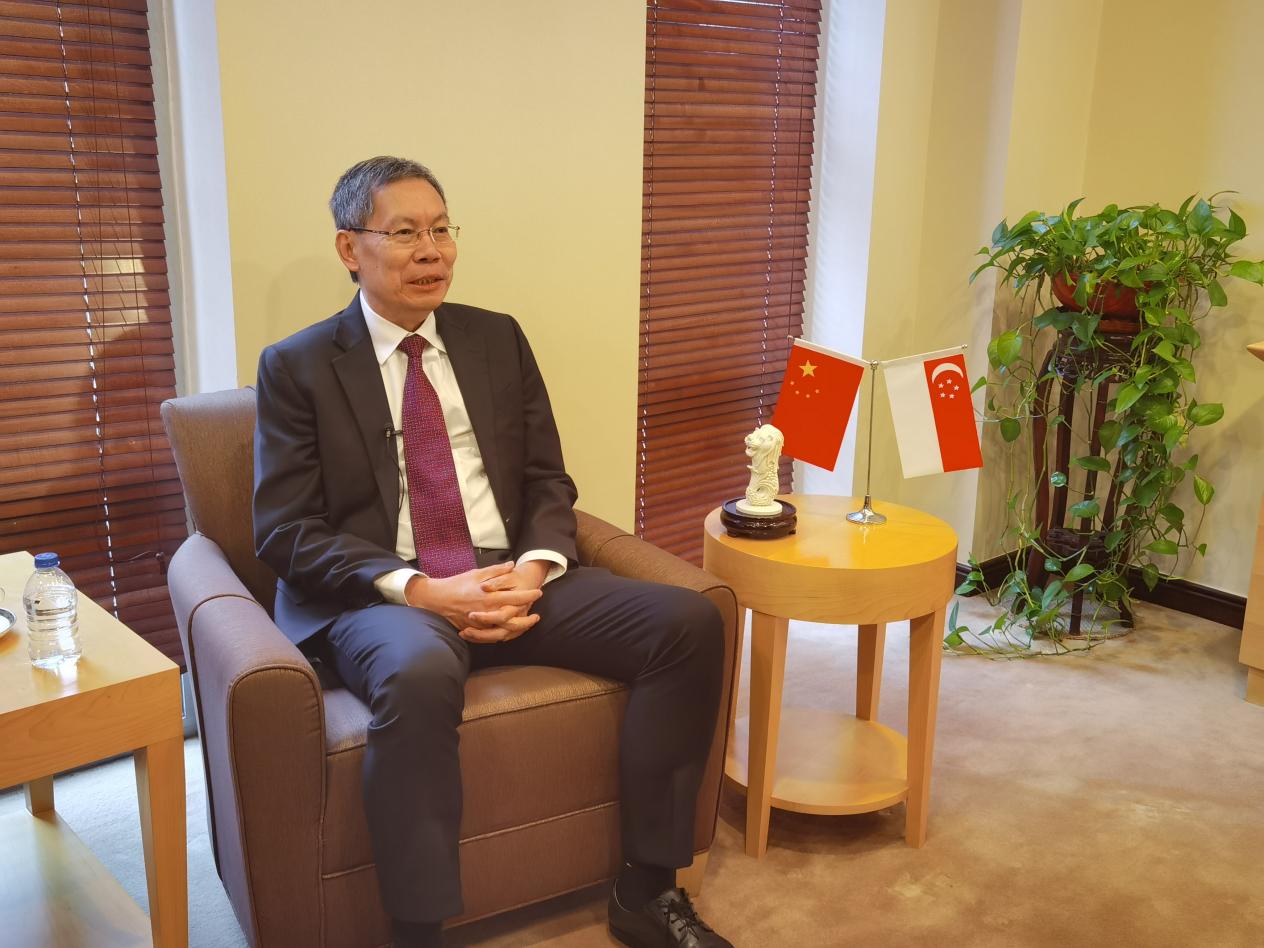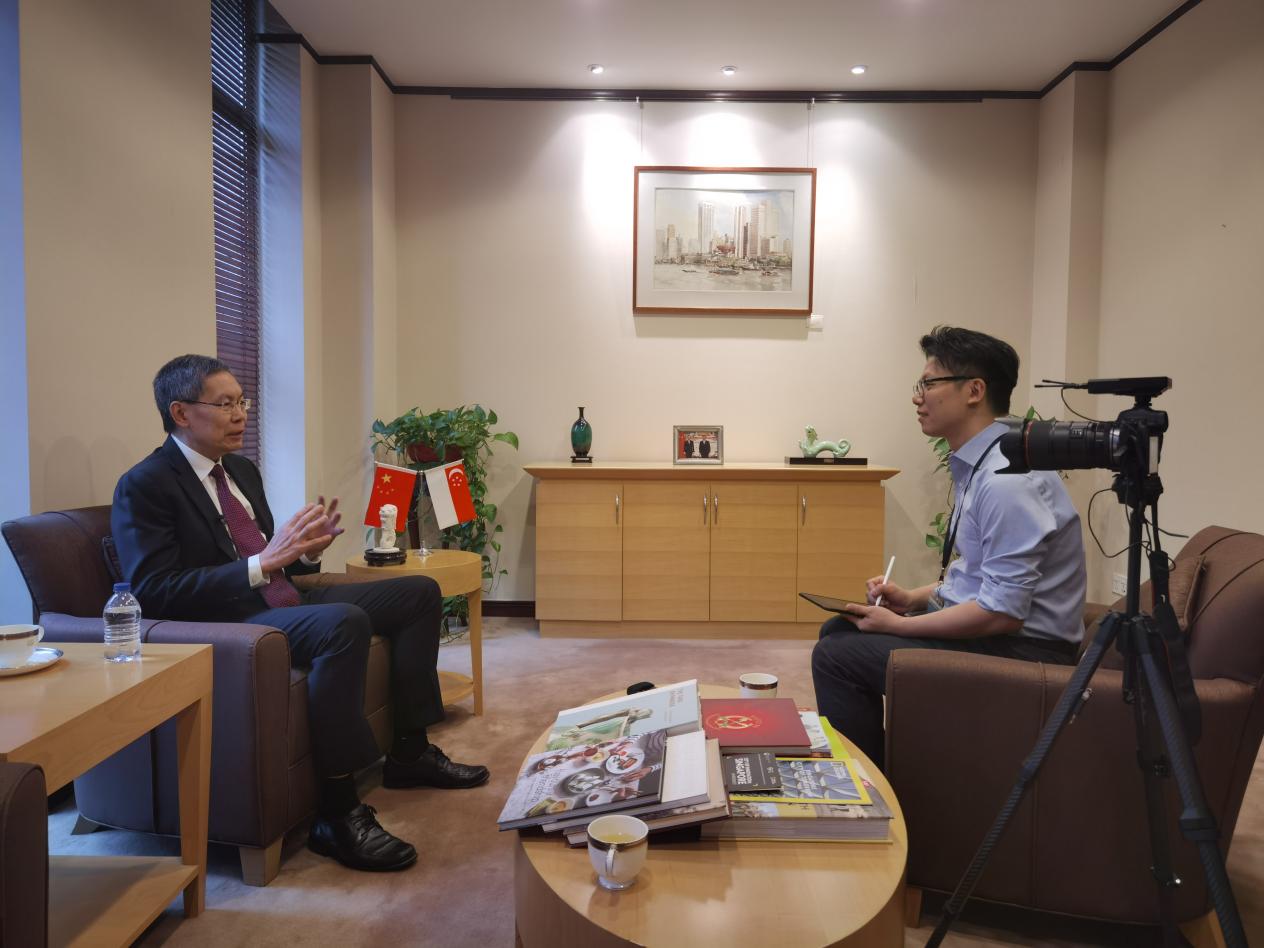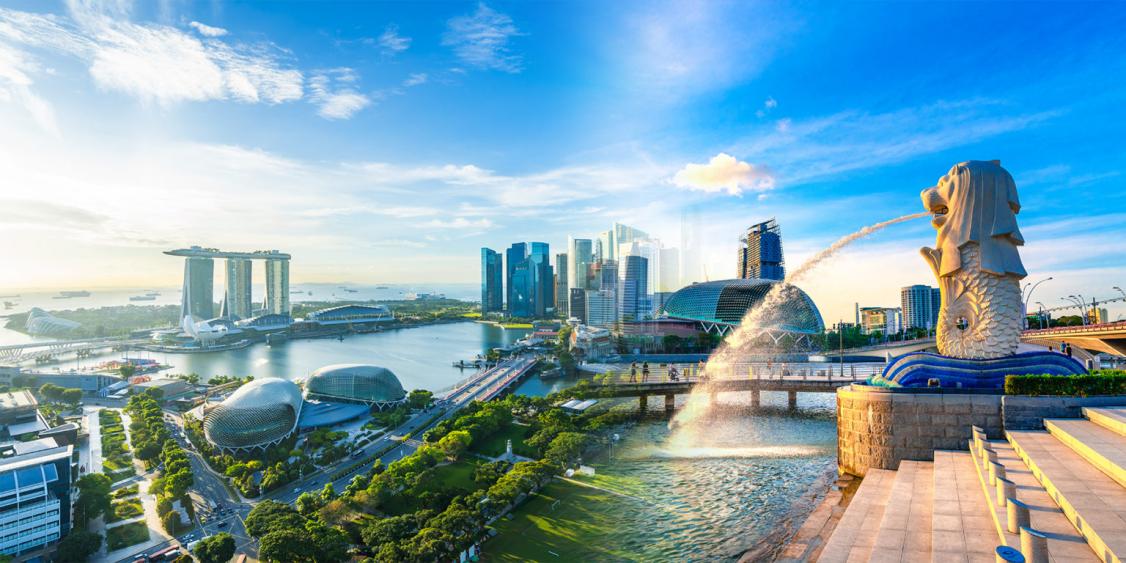

Written by Guan Qiuyun / Translated by Chen Zhiying
2021 marks the 30th anniversary of China-ASEAN dialogue relations. With major changes and a global pandemic unseen in a century, this year's milestone significance becomes even more special. Under this background, China and Singapore adhere to mutual trust in politics, mutual benefit in economy, communication and exchange in culture, and close cooperation under the pandemic... Both sides forge ahead and cultivate friendship, which not only provides impetus for China's domestic and international dual circulation, but also boosts Singapore's economic recovery, transformation and upgrading, and even adds luster to the friendly China-ASEAN relations.
Recently, reporters of China-ASEAN Panorama Magazine went to Beijing to interview H.E. Mr. Lui Tuck Yew, Ambassador of Singapore to China, and listened to His Excellency talk about the cooperation and development between China and ASEAN and between China and Singapore.

Singapore takes promoting China-ASEAN relations as its duty
Along the way, China and ASEAN have made many remarkable achievements and accumulated plenty of valuable experience. As one of the founding members of the ASEAN in 1967 and also an ASEAN country at the forefront of regional development in various fields, Singapore has long regarded promoting China-ASEAN relations as its own responsibility, whether for regional stability or its own development.
According to Mr. Lui Tuck Yew, when Singapore took over the rotating presidency of ASEAN in 2018, it launched the plan of building ASEAN Smart Cities Network. The main purpose of this plan is to unify major cities in China-ASEAN region and show them the way forward in terms of creating ecosystems that will allow business to flourish and people to congregate. Many years ago, Singapore envisaged to integrate these cities into a same network for centralized management and implemented electronic systems, so that urban services and governance would become more intelligent. Since 2018, Singapore has been working hard to make this conception come true. Mr. Lui Tuck Yew also said that Singapore has also played an active role in promoting the Code of Conduct in the South China Sea. In 2018, Chinese State Councilor and Foreign Minister Wang Yi went to Singapore to attend the China-ASEAN (10+1) Foreign Ministers’ Meeting. At the meeting, China and ASEAN countries reached an agreement on the single draft negotiating text of the “Code of Conduct in the South China Sea”.
In terms of economy, trade and investment, Singapore officially ratified the Regional Comprehensive Economic Partnership Agreement (RCEP) on April 9, 2021, becoming the first ASEAN country to do so. This has not only injected vitality into bilateral trade exchanges between China and Singapore, but also sent out a strong message of promoting world free trade, multilateralism and economic linkage within the region.
“RCEP brings together 10 ASEAN countries and five important dialogue partners, showing its determination to strengthen multilateral trade and economic chain in the region. This agreement will promote economic and trade exchanges between Singapore and China and enable more Singaporean companies to provide services in China. In terms of market access, the reduction of tariffs has reached more than 90%. This is conducive to accelerating the economic recovery and economic growth between China and Singapore and between China and ASEAN after the pandemic.” During the conversation, Mr. Lui Tuck Yew showed Singapore's confidence in the prospect of the RCEP.
The 18th CAEXPO to be held from September 9 to 13 this year will also help enterprises expand the market space from providing services for China and ASEAN countries to RCEP member states and counties along the Belt and Road. As one of the important co-organizers of the CAEXPO, Singapore has always given strong support to the Expo. “The CAEXPO is an important platform for communication between ASEAN and China. Enterprises in the region can get benign interaction and exchange. On the 30th anniversary of China-ASEAN dialogue relations, I would like to extend my best wishes to the 18th CAEXPO,” said Mr. Lui Tuck Yew.
New Land-Sea Corridor helps stabilize regional industrial chain and supply chain
Singapore is the ASEAN country with the largest number of Government-to-Government level project with China. From Suzhou Industrial Park in the 1990s to Tianjin Eco-city in 2008 to China-Singapore (Chongqing) Demonstration Project on Strategic Connectivity in 2015, there are three G-to-G projects between the two countries. The two sides have promoted cooperation from industry and ecology to service industry, logistics and connectivity, reflecting the characteristics of China-Singapore economic and trade cooperation, which is keeping pace with the times and continuing to explore and innovate.
When it comes to the third G-to-G level project between China and Singapore, Mr. Lui Tuck Yew said: “The third project is in the western region and focuses on the area of connectivity of financial dervices, transport, logistics, aviation and so on. Then when we looked at what key features we would able to bring to the table, we decided that because the Belt and Road is an aspect of China's development, we felt that we could bring together the Overland Silk Road linking western region to Europe and the Maritime Silk Road linking China to Southeast Asian region through this International Land-Sea Trade Corridor. This connects Chongqing to Qinzhou Port in Guangxi.”
So essentially, what does this trade corridor do? Taking shipping efficiency as an example, Mr. Lui Tuck Yew introduced to our reporters: “In the past, most of the goods from Chongqing in the western region would be transversed to Yangtze and reach the eastern seaboard. It took almost three weeks. With this corridor, it takes about a week, so it actually opens up a new egress route from China to Southeast Asia And if you look at the reduction in time, it obviously is very important for items like agricultural goods, vegetables, fruits and so on. The other thing actually is if you look at some of the ports in China now, because you are doing so well and also because of inspection backlogs and so on, there's actually quite a bit of congestion, whereass in Qinzhou Port, you do not have those problems. Going foward, it can be an important feature for entry and exit of goods into and out of the western region.”

Under the pandemic, the New Land-Sea Corridor has played a very positive role in stabilizing regional industrial and supply chain. Mr. Lui Tuck Yew highly affirmed the corridor and said that it successfully alleviated the impact of the pandemic and became a new effective trade corridor linking Southeast Asia and China's western region. It strengthened the resilience of bilateral trade routes and supply chain, and promoted the smooth flow of food, medical supplies and other necessities, thus providing strong support for fighting the pandemic.
Looking to the future, people are more concerned about the futue development of the New Land-Sea Corridor. According to Mr. Lui Tuck Yew, Singapore will focus on how to optimize the existing trade mechanism and create a review system to put electronic bill of lading into use, which will help to reduce the number of inspections, the customs requirements, and that will facilitate the movements of goods even more. Mr. Lui Tuck Yew also said that currently, China and Singapore boast great cooperation momentum. He believed that with the improvement and upgrading of the New Land-Sea Coridor, cooperation between China and Singapore will continue to expand.
Singapore's experience in sustainable development cooperation
2021 not only marks the 30th anniversary of China-ASEAN dialogue relations, but also the Year of China-ASEAN Sustainable Development Cooperation. As a model of urban sustainable development in the China-ASEAN region, the experience of the green Singapore is of great reference value to China.
Mr. Lui Tuck Yew talked to our reporters that sustainable development in Singapore began as early as 1967. In 2020, Singapore put forward the Singapore Green Plan 2030, which is expected to quadruple the output of renewable energy by 2025. To this end, Singapore piloted a floating solar panel farm on the surface of the reservoir. It is the world's largest inland floating solar panel farm, but it was born in Singapore, one of the smallest countries in the world. In terms of waste treatment, Singapore used the ash generated by waste incineration as road building materials, and the remaining unusable parts will enter the landfill. In terms of reducing greenhouse gas emissions, Singapore has committed to making the public transport system more convenient, to ensure the public transport accounts for 75% of the national travel modes. At the same time, it implements the “zero growth” policy for motor vehicles and increases the cost for private vehicle owners.”

It is worth mentioning that Singapore is not limited to its own development, but actively shares experience and carries out cooperation with partners in the region.
In June 2021, Mr. Lui Tuck Yew visited China-Singapore Tianjin Eco-city. This project is a starting point of China-Singapore cooperation on sustainable development and ecological protection. In June, reeds swayed in the wind on the bank of Tianjin Jinghu Lake, waterfowl crossed the clear lake from time to time, and the streets were lined with green trees. The construction of ecological civilization brought tangible benefits to local residents. Over the past decade, China and Singapore have cooperated to explore new ways of city sustainable development under resource constraints, with a total of 38 eco-cities and parks being built and opened to the public. When mentioning the China-Singapore Tianjin Eco-city in the interview, Mr. Lui Tuck Yew also praised this cooperation achievement.
Since this year, Mr. Lui Tuck Yew has paid attention to the currently trending energy structural adjustment in China. He said that China has ambitious targets in energy conservation and emission reduction. It now has its own carbon emission trading market, and carbon emissions come with a price tag. China and Singapore can cooperate and exchange experience in sustainability and ecological solution.
Looking back, Singapore is a vital link that strengthens China-ASEAN relations and promotes both sides to create a better life for people in the region with their strength. Focusing on the current situation, Singapore is a solid bridge connecting China and ASEAN, and plays an important role in mobilizing cooperation resources and gathering cooperation momentum for both sides. Looking forward to the future, people expect and believe that Singapore will make more contributions to China and ASEAN with its great influence.
桂ICP备14000177号 Copyright@2006-2013 Guangxi China-ASEAN Panorama Magazine Agency Co., Ltd. All Rights Reserved